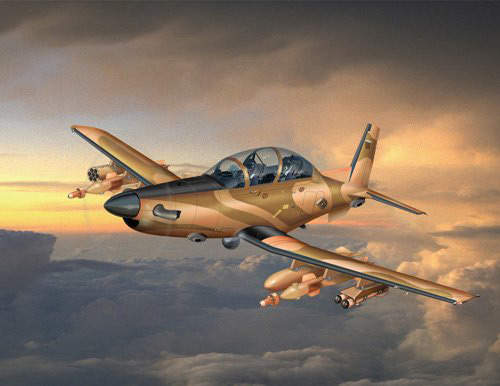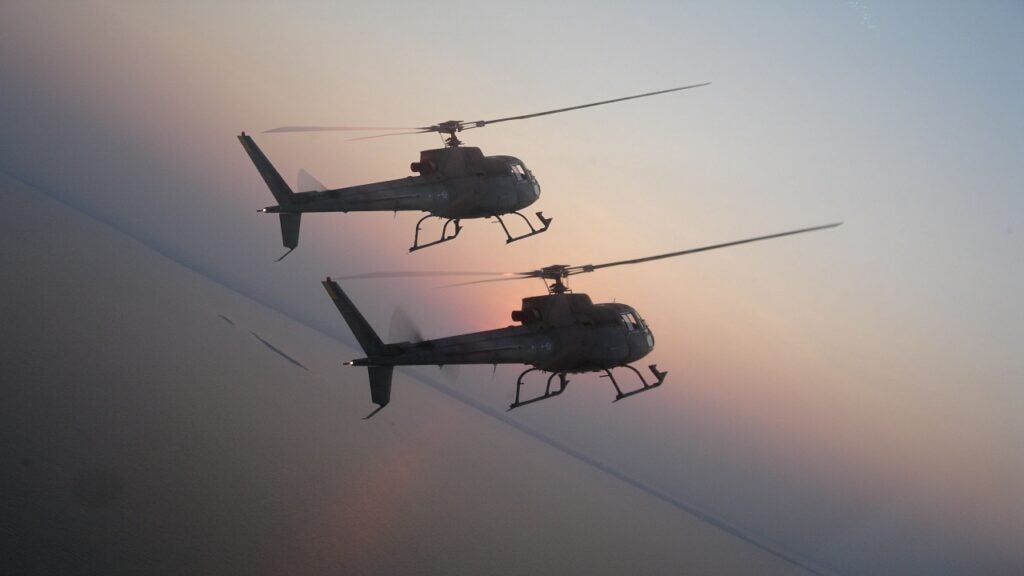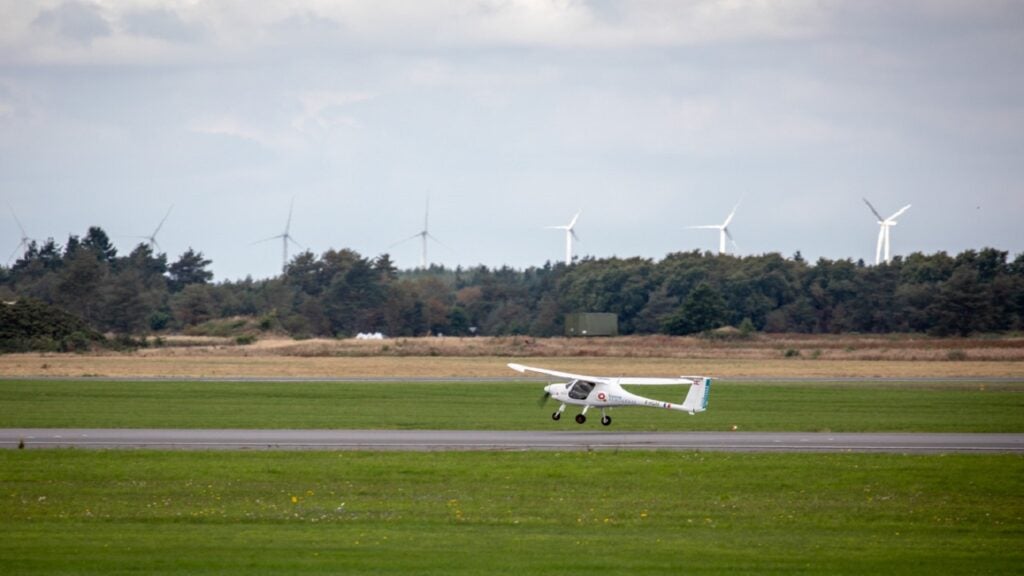
During the Farnborough Air Show in 2006, Hawker Beechcraft formally announced plans for the next spiral development of the successful T-6 platform into the AT-6B aircraft for the net-centric battlefield.
Through the addition of open architecture avionics, state-of-the-art sensors, datalinks, cockpit and aircraft protection components and various weapons capabilities to the proven training platform, the Beechcraft AT-6B provides multimission capability on a low-cost platform. HBC showcased the AT-6 at the Royal International Air Tattoo and Farnborough International Airshow in the UK in 2010.
The multirole, multimission system is designed for net-centric intelligence, surveillance and reconnaissance (ISR) and light precision attack missions.
The AT-6 design allows for advanced training with weapons delivery capabilities and the ability to conduct actual operational missions with the same platform.
AT-6B programme and development
The AT-6 prototype completed its first flight in September 2009, and entered the next phase of flight testing. The second AT-6 prototype, which is powered by a Pratt & Whitney Canada PT6A-68D engine completed its maiden flight on 5 April 2010. Each engine can produce 1,600shp (1,193kW) of power.
HBC completed the operational assessment of AT-6 aircraft at Davis-Monthan Air Force Base in Tucson, Arizona, in October 2010. The AT-6 dropped 25lb BDU-33 and 500lb BDU-50 training rounds during the testing. Pilots from the US Air Force and the Air National Guards participated in the assessment and submitted written evaluations of the aircraft’s performance.
On 19 July 2010, HBC signed a contract with US-based CAE to supply ground-based training systems for the AT-6 aircraft. CAE will design and analyse the training system and synthetic training equipment. It will also develop courseware, class room, simulator instruction and embedded aircraft simulation solutions for the AT-6.
AT-6 trainer mission roles
As well as being an initial trainer, the multirole AT-6 will be capable of performing missions including: net-centric ISR with the ability for precise geo-registration, streaming video and datalinks, light attack including combat search and rescue (CSAR), close air support, forward air control and convoy escort, homeland defence (border security), port security, counter-narcotics operations and civil missions such as disaster area reconnaissance, search and rescue and firefighting.
Cockpit of the AT-6B light attack aircraft / trainer
The Beechcraft AT-6 is integrated with CMC Electronics’ glass Cockpit 4000 avionics suite and has the same cockpit design as that of the T-6B. The open, flexible and redundant architecture offers an integrated approach for cockpit and weapon system management.
The avionics suite includes primary flight, engine and navigation displays, flight management systems, global positioning systems, head-up displays, navigation and mission processors, multifunction displays and control panels.
There are tandem HOTAS (hands on throttle and stick) controls fore and aft for pilot and instructor.
AT-6B avionics
The AT-6B fully integrated avionics system uses two powerful mission computers to control weapons deliveries and other mission related functions. Integrated navigation and mission data is displayed on the large, 25° total field of view (TFOV) head-up display (HUD) and on three high-fidelity 5in×7in multifunction displays (MFDs).
The up-front control panel (UFCP) provides central control of navigation, air-to-air and air-to-ground master modes from the front and rear cockpits. It also supports radio communication and navigation aid management, weapon selection and programming, waypoint management and designation of markpoints.
The primary flight display (PFD) provides the controls and displays required to manage and present primary flight information to the pilots including attitude, airspeed, altitude and flight path direction.
The tactical situation display (TSD) enhances situational awareness by presenting a scalable plan view of the key elements required for terminal, en route, area and tactical navigation.
The colour digital moving map display (MAP) presents the aircraft’s relationship to the outside physical environment. It also provides key flight, navigation and tactical display of information to give the crew a high degree of situational awareness flights.
An engine instrument and crew alerting system (EICAS) provides aircraft and engine system information including status of the engine, propeller, hydraulic, fuel, trim and flap.
The avionics suite also includes a data transfer system for navigation and operation planning and a digital video recorder for mission debrief.
Head-up display (HUD)
The HUD is critical for both navigation and mission performance. It provides the pilot with all critical flight and weapons information, enabling effective and safe aircraft control while manoeuvring.
The HUD has a large 25° total field of view (TFOV) and high symbol brightness of more than 3,000ft lamberts, for operating in bright sunlight.
The HUD is fully night vision goggle (NVG) compatible. It displays critical flight information such as the flight path marker, pitch reference, climb dive marker and climb dive ladders. Basic flight data is displayed independent of master mode selection or de-clutter level.
AT-6B communication technology
In addition to UHF / VHF / UHF and SATCOM, communication systems can include, enhanced position location and reporting system (EPLARS), joint tactical information distribution system (JTIDS) and situation awareness data link (SADL).
Weapon systems
The AT-6B is equipped with a sensor suite that can include a variety of electro-optical, infra-red, laser and hyper-spectral sensors, for example the Wescam MX-15Di. The Boeing joint helmet-mounted cueing system, in service with the USAF and the US Navy, can be fitted for targeting.
There are six wing-mounted hardpoints for stores. With its MIL-STD 1760 smart weapons interface, the AT-6 can be armed with a variety of weapons including 0.50 calibre machine gun pods, air-to-ground missiles like Hellfire and Maverick, AIM-9 Sidewinder air-to-air missiles, munitions including Paveway II / enhanced Paveway II / Paveway IV guided bombs, joint direct attack munition (JDAM), small diameter bombs (SDB) and 2.75in rocket pods.
In September 2011, Raytheon unveiled its plans to incorporate Griffin missiles on the AT-6 to provide the warfighter with persistent surveillance and low collateral damage during counterinsurgency and irregular warfare missions.
Griffin is an air and ground launched precision guided missile which enables the AT-6 to lock targets through a simple graphic user interface.
Self-protection systems and armour
The AT-6 is fitted with cockpit and engine armour for increased aircraft protection.
An infra-red countermeasures suite can include the AN/AAR-47 missile approach warning system and ALE-47 countermeasures dispenser system.
Engine and performance of Hawker Beechcraft’s aircraft
The aircraft uses a Pratt & Whitney Canada PT6A-68 turboprop engine which provides a flat rated 1,100hp (820kW).
The range of the aircraft is more than 1,667km.
The AT-6 can fly at a maximum speed of 585km/h. Its cruise and stall speeds are 500km/h and 185km/h respectively. The range of the aircraft varies between 1,575km and 2,779km. Its service ceiling is 7,620m (with stores) and 9,448m (clean). Its maximum take-off weight 2,948kg.
An already well-established logistics infrastructure currently supports more than 450 aircraft at six US and two international locations, with planned support continuing through to 2050.
US Defence Sector – Market Opportunity & Entry Strategy, Analyses and Forecasts to 2015
Detailed analysis and forecasts of the US defence market are available from our business information platform Strategic Defence Intelligence. For more information click here or contact us: EMEA: +44 20 7936 6783; Americas: +1 415 439 4914; Asia Pacific: +61 2 9947 9709 or via email.




